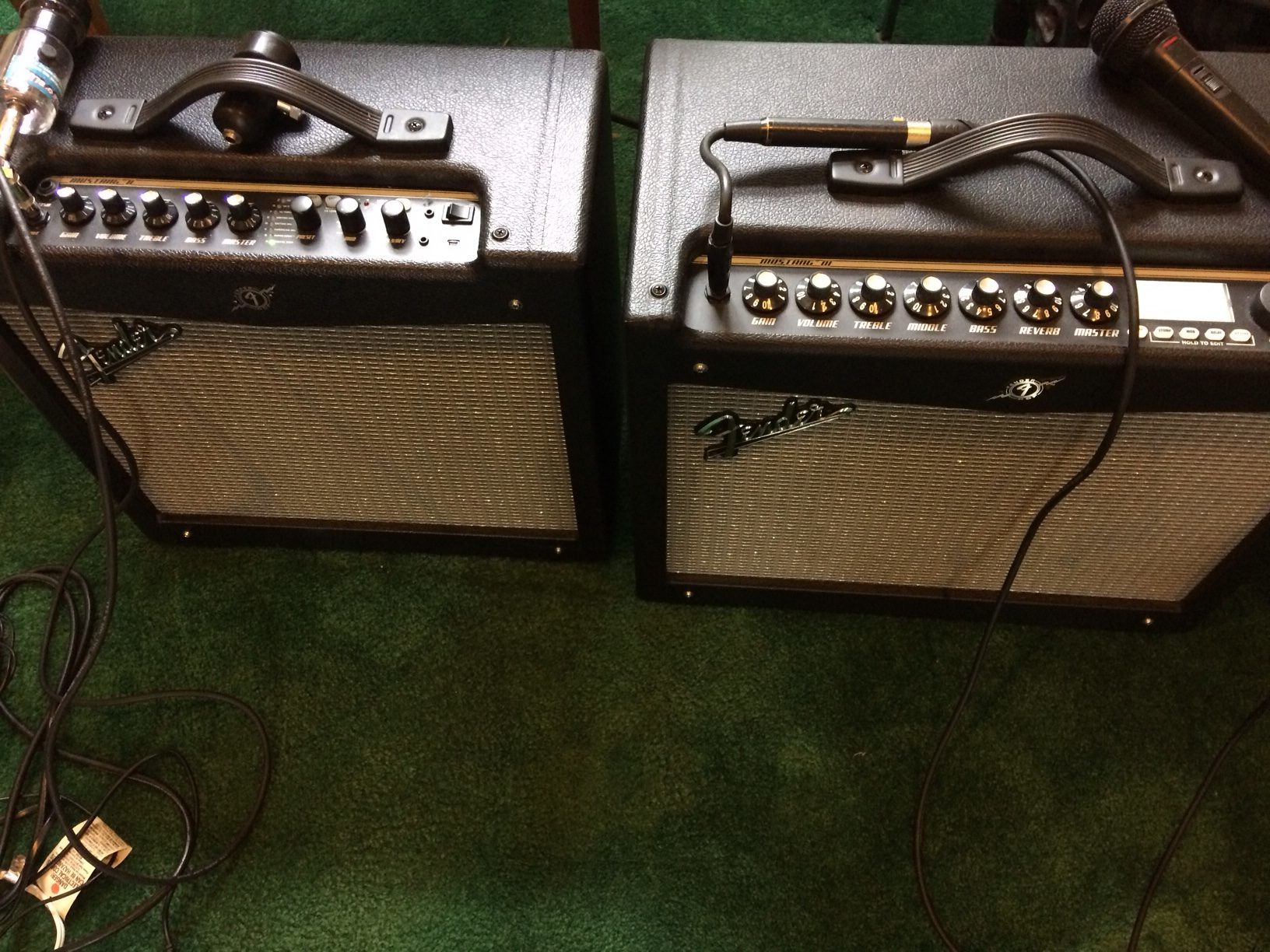
What’s the best choice for your first (or next) amp?
A frequent question from novice harp players is: what should I buy for my first amped setup? Some of the people reading this are going to buy an amp for themselves or someone else for Christmas, or buy one after Christmas with their Christmas money. So here are a few things to keep in mind when you head to the store. (NOTE: this advice is aimed mainly at harmonica players, but the basic concepts apply to just about anything you play through an amp, e.g. guitars, keyboards, and so on.)
What’s included in any setup for amped harp
The basic elements of a complete setup for harp are:
– a harmonica (of course!)
– a microphone
– a microphone cable to connect the mic to an amp. For a lo-z mic that you’re planning to plug into a 1/4″ input on your amp, you also need an inline lo-z to hi-z transformer that attaches to the end of your XLR mic cable.
– an amplifier to make the signal from the mic louder, and possibly to change its tone too
– a reverb or delay pedal to sweeten the sound. You can scoff if you like and say “I don’t need no stinkin’ effects”–I defy you to show me ONE great record in your collection where the harmonica is not recorded with reverb, delay, or both. In my opinion, delay is an absolutely mandatory effect for amped-up harp, and reverb is mandatory for “acoustic” harp sounds. However, if money is really tight, you can put a delay or reverb pedal on your wish list and move on.
If your instrument is a guitar or a keyboard, the basic elements include the instrument, the amp, and a 1/4″ cable to take the signal from the instrument to the amp. As you can see, things get a little more complicated when microphones are involved.
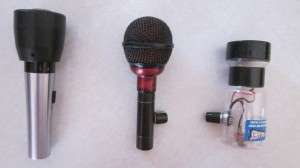
Optional elements include more effects, loopers, different styles of amps and mics for different kinds of gigs, and so on. But the list above is the minimum. If you don’t have a harp, a mic, a mic cable, and an amp, you ain’t gonna be heard above the crowd.
So that’s the basics. Now let’s talk about setups for specific styles.
Get the right gear for your style
When you think about any setup, the first thing you want to ask is: what kinds of sounds do you want to make with that setup? If you want a dirty amped Chicago blues or rock type sound, that leads you to one set of choices. If you want to be able to make clean, sweet sounds, that takes you in another direction. If you want to do both, that’s another set of choices.
In general, if you want to play a lot of different styles with a lot of different sounds, the most cost-effective way to do so is to use a self contained modeling amp like the Fender Mustang series or an amp modeling device like the Digitech RP or Zoom G3 coupled with a PA or keyboard amp. Either setup contains a huge assortment of traditional and modern sounds in delivery systems with plenty of power at low cost. We think every player should consider such a solution when they decide to upgrade or expand their rig.
Amped harp, Chicago style
For a traditional “amped” Chicago-style sound for either electric guitar or harp, the traditional approach since 1947 is to get a small (5-6 watt) tube amp. If you’re a guitarist, just plug it in and play. For a harp player, coupled with a bullet-type mic (such as the Blowsmeaway Bulletini), a harp-specific mic like the Lone Wolf Jason Ricci signature model, or a Bottle O’ Blues, this will create the Chicago sound. (The mic REALLY matters–it changes the sound just as much or more than the amp. Check out this post for samples of how drastically the mic affects the sound.) For even better results, add a delay pedal. A 5-6 watt tube amp will run you $200-250 new; a bullet mic will cost another $150 to $275, a bottle o’ blues about $100; and a delay pedal will cost another $50-100. (For a first amp, I recommend buying new, because if something goes wrong you’re better off taking it back to a store than trying to chase down the guy you bought it from on eBay.)
Good amp choices in this category include the Fender Champion 600, the Epiphone Valve Junior (especially with the half-stack speaker option), the Crate V8 (or its predecessors and ancestors by Crate, like the VC508 I own), the VHT Special 6 (whihc has a 10″ speaker for lots of low honk), and the Stage 5. The last one on this list is getting a lot of attention lately, and I’ve seen some live videos that sounded good. It’s got some nice pro touches, like a line-out to the PA for when you need to play rooms where 5 watts won’t cut it, and it’s well-priced. Any of these (coupled with the right mic) will give you the traditional Chicago sound, and while you may want a larger amp at some point, these small amps will continue to sound good throughout your life as a player. I still pull my Ron Holmes-modified Crate VC508 from the closet every so often, and it still makes a great sound.
A second, less traditional approach to getting a dirty Chicago-type sound is to use a “modeling” amp, such as the Fender Mustang, Vox VT or DA series (I have a DA5, and I love it), or Line 6 Spider V series amps. These amps combine electronic “modeling” of amplifier circuits with physical hardware like a cabinet and speaker. The advantages of this approach are that these amps generally come with lots of FX built in, they can mimic the sounds of a lot of tube amps, not just one, and they tend to cost less than a tube amp of comparable power, so overall you get lots of sound per dollar. If you go this route, look for a modeling amp that includes models of tube amps that are widely used by harp players, such as the Fender Champ, Deluxe, or Bassman, the Silvertone series, Sears amps, etc. (As this list shows, amp models of cheap, small amps tend to sound good with harp–just like the real things.) Some modeling amps are based on models of very high-gain amps that sound great with metal guitar, but produce a lot of feedback when used with a mic, and you want to be careful about that. The Fender Mustang series is a good bet for amp models that include plenty of well-known Fender tube amps and speaker cabs along with great raunchy models of cheapo small amps, which is good stuff for harp players, and we offer a patchset expressly designed for amped blues with the Mustang amps.
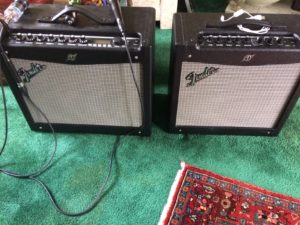
The software that manufacturers supply for their modeling devices are an important part of the overall package–it lets you access features and functions that you can’t get to otherwise. Take the time to see whether you like the way the manufacturer’s software works on whatever it runs on (PC, Mac, iPad, whatever). Obviously, if you like to keep the computer out of the picture, or if you like things really simple, you may want to go the more-traditional route.
Like I said, the value for money ratio with these amps is generally high. A Fender Mustang III v.2 amp with a 12″ speaker and 100 watts of power sells (used) in the range of $200-250–not at all bad for a very potent stage-ready blues harp amp that works well too for acoustic harp and vocals (though only one at a time–there’s only one input, and even if you plug a mixer into it, you only have one amp sound at a time). A new Fender GT100 Mustang, their latest rev of this series, also equipped with 100 watts of power and a 12″ speaker, sells for less than $400 new.
A third option is to use an amp modeling device, like a Digitech RP or a Zoom G3/G3X loaded with my patch sets for those devices, coupled with a clean amp like a keyboard amp or a PA. A version of this setup based on a Digitech RP happens to be my favorite, and it’s described in more detail in the section below on getting both clean and dirty sounds from a single amp.
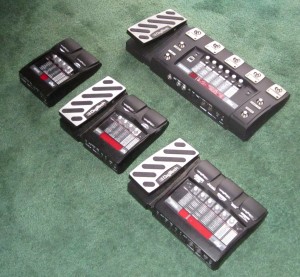
Please note that if you buy a modeling amp or amp modeling pedal, it will almost certainly not be set up out of the box for harmonica. That’s not a problem with amps like the Fender Mustang, which has front panel controls that look and work just like the ones on the real amps they represent. But if you don’t like messing with more than a few dials ever, consider budgeting for one of my patch sets too. I spent hundreds of hours programming those things, and unless you have that kind of time you might consider my stuff.
Sweet and clean
For a clean, sweet sound, you want a different mic and (usually) a different amp. For a mic, go for an Audix Fireball V or a decent vocal mic like the Shure SM57 or SM58; these mics and similar ones from competitors cost in the neighborhood of $100-150, which is pretty good considering that these mics can be used for both vocals and harmonica. For the amp, go for a small PA system or keyboard amp, ideally one with built-in reverb and delay. I’m very fond of Peavey’s keyboard amps, especially the KB-2, which has plenty of power, a 10″ speaker, a built-in 3 channel mixer and line out, and sells for $250 new. It’s an especially good choice if you think you want to sing through the amp as well as play through it, though you will need to buy a reverb or delay to go with it. Look for something with 40-50 watts of power and 10″ speakers at least. The same applies if you go for a powered PA speaker, which is a great choice if you don’t need more than one input for your mic. (If you need more than one input, you need to budget for a mixer too. Simple 1/4″ 4-in 1-out mixers can be acquired for $25.)
Don’t be tempted by the VERY small keyboard amps available from Behringer (the KT108, less than $70) and Peavey (the KB-1, over $100). I own the Behringer KT108, and it’s a fine little amp for practicing and quiet jam sessions, but not much else. Again, if you plan to use the amp for performance as well as practice, I recommend an amp with a 10″ speaker at least. A setup that includes a Peavey KB-2, Fireball V, mic cable (you don’t need a transformer with this setup), and delay or reverb pedal costs about $500 new. Use a small PA instead of the Peavey and you cut $50 from that price; with the Behringer KT108 subbed for the Peavey amp, the price is about $325 (you do need an inline transformer with that amp).
Note also that the Fender Mustang series amps, which I discussed above in terms of their amped-up capabilities, happen to be very good at producing clear, clean tones with a dusting of delay or reverb, with plenty of both to choose from. In terms of sheer power, flexibility, and price for performance they’re outstanding choices for harmonica players playing in virtually any style. However, if your blues mic is a bullet, you should switch to a Shure SM57 or SM58 for cleaner, sweeter tones.
Clean and dirty in a single setup
To get both clean and dirty sounds, you need to start with a clean setup. You can’t start with a mic and amp that are designed to dirty things up, because you’ll never be able to make that setup sound clean. You have to start with gear that makes clean sounds, and add stuff to dirty it up, at least if you’re trying to use a single setup for both sounds (which is certainly doable). So we start with the same rig we’d use for clean sounds, as described above. Then we add an amp modeler to dirty the sound up. (We can also start with a device that looks like a traditional guitar amp–more or less–and includes an amp modeler, like the Fender Mustang series amps.)
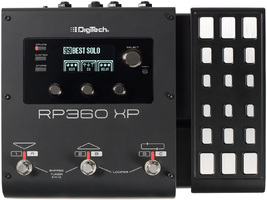
The Digitech RP360XP and RP500 are best-in-class choices at $200 new; Digitech has discontinued the RP155, 255, and 355, but all of them are widely available on the used market at very low prices (in the neighborhood of 20-30% of original list price, like $50 for an RP255 and $75 for an RP355). Adding my patch set will load your RP with a big collection of amped and clean sounds, including lots of great reverbs and delays, for another $30 for the RP255, $35 for the RP355, or $50 for the RP360XP/RP500. (My own choice these days is a Digitech RP360XP or RP500 running my patches; you can read more about it here.) You can hear the RP500 at work on my record “The Lucky One,” where every harp track (and there are lots of ’em) was recorded with an Audix Fireball V mic into a Digitech RP500 and straight to the board from there. Check out the links to iTunes and Amazon at the bottom of the page.
A second option in an amp modeling device that has the added benefit of running on batteries, which makes it more portable and faster to set up, is the Zoom G3/G3x. This is a full-blown multiFX device that makes a lot of very cool sounds in addition to basic bread-and-butter amped and acoustic harp sounds. The G3 sells new for $150, and the G3X, which in includes a very useful expression pedal, sells for $50 more. My patch set for the G3/G3X gives you 30 outstanding harmonica tones for $40.
If you want something very simple and very focused, there are a number of single-purpose pedals that can take a clean signal and dirty it up in a harp-friendly way. If you rarely use amped tones but want them available, a simple device like the Joyo American Sound will give you a range of Fender amp tones for about $40. Simple, easy to use, sounds good.
Other options (at higher prices) include the Lone Wolf Harp Attack pedal and the Tech 21 Blonde v2 pedal. The Joyo American Sound is basically a copy of the Blonde at a much lower price point.
The price for this kind of setup starts at about $500-550 for a Peavey KB2 amp, Fireball V or Shure SM58 mic, used Digitech RP255 or Zoom G3 multiFX device, cable, and transformer. A version of this setup built around a Fender Mustang III v.2 modeling amp would run about about the same. A version that uses a Digitech RP500, a much better device for performance, would run another $100; using the Joyo American Sound for the amp model would run about $150 less. You can add another another $50-100 if you want to add a delay and/or reverb to the Joyo, which you really should. (A Mustang, RP, or Zoom device is really a very economical solution as well as a great-sounding one.) Finally, you need to budget $20-25 for a 1/4″ guitar cable to take the sound from the amp modeler to the amp (except with the Mustang).
When wall power is available, I tend to prefer a Digitech, because an RP has just got lots of great stuff in it in a very performance-ready package. If I’m playing straight-up blues or other material where the sounds have to be traditional, I use the Mustang III.
That’s my story and I’m sticking to it. I hope this is useful information. Let me just note in closing that gear in general is a lot better and less expensive than it used to be, and it’s a lot easier to find good stuff than bad stuff. So whatever you get, don’t stress out. And if you don’t like the sound you’re hearing through the amp, listen to yourself without the amp, and see whether you need to improve your sound before it ever gets to a microphone. The better you sound without an amp, the better you’re going to sound with one.
Finally finally: never buy a piece of gear without checking out every user review you can get your hands on. Harmony-central.com is a good place to start. The user reviews at musiciansfriend.com and sweetwater.com are well worth a look too.
the 21st century blues harmonica manifesto in sound
Get it on Amazon
Get it on iTunes
the rock harmonica masterpiece
Get it on Amazon
Get it on iTunes
Tags In
Related Posts
23 Comments
Leave a Reply
You must be logged in to post a comment.
WHAT’S NEW
Categories
- Audio/Video
- Blog
- Blue Future
- Digitech RP Tricks and Tips
- Discography, CDs, Projects, Info, Notes
- Featured Video
- For the Beginner
- Gallery
- Hunter's Effects
- Hunter's Music
- Huntersounds for Fender Mustang
- Meet the Pros
- More Video
- MPH: Maw/Preston/Hunter
- My Three Big Contributions
- Player's Resources
- Pro Tips & Techniques
- Recommended Artists & Recordings
- Recommended Gear
- Recorded Performances
- Reviews, Interviews, Testimonials
- The Lucky One
- Uncategorized
- Upcoming Performances
- Zoom G3 Tips and Tricks
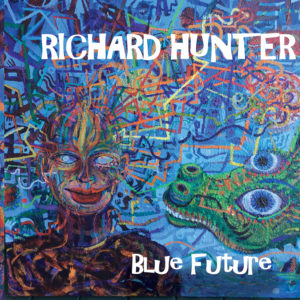
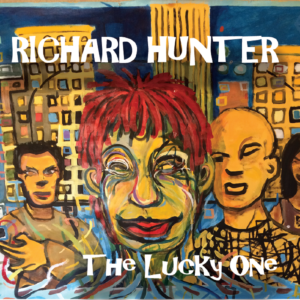

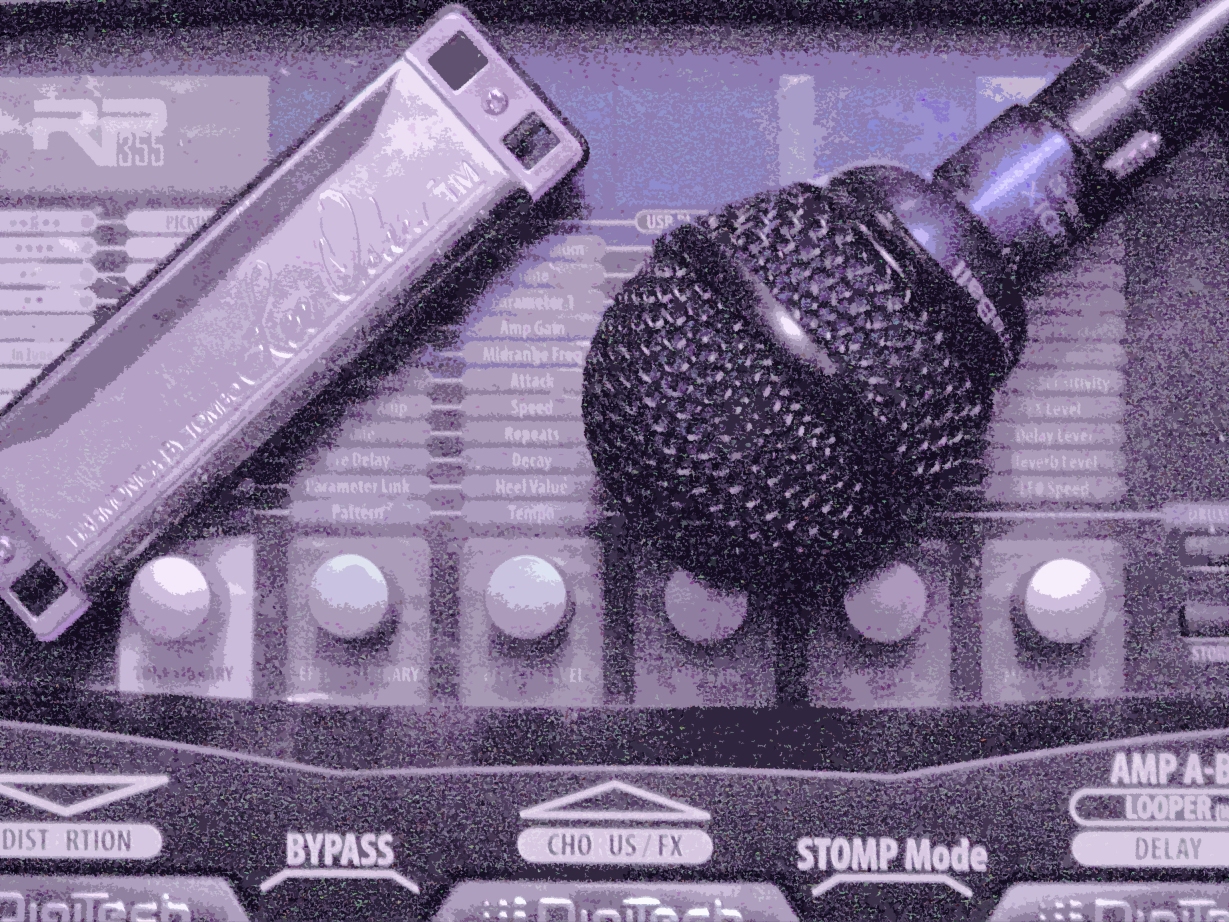
Hi Richard! I love your website! I want to get a pedal (either the Lone Wolf Harp Attack or the Tech 21 Blonde)…Can you please tell me what determines whether or not I will need a DI box, if I want to go directly into a PA, without using an amp? Thank you very much !!! Skip
You need a DI box if your cable run from the device to the PA is over 50 feet long. You also need a DI box if your PA only accepts XLR inputs, and the output on your device is 1/4″; in that case the DI box will convert your 1/4″ output into an XLR output for your PA.
However, most PAs have a 1/4″ input on most channels, and you can just plug the output from your Lone Wolf or Tech 21 pedal straight into that.
I’D LIKE TO KNOW IF THE RP 55 WILL ACCEPT ALL OF THE PATCHES/PATCH SETS THAT THE RP 500 DOES ? I’M INTERESTED IN ALL OF THE CLASSIC FENDER AMPS THAT WERE USED FOR THAT CHICAGO – STYLE BLUES HARP SOUND . I’D ALSO LIKE TO KNOW IF IT CAN BE RUN INTO A MIXER/PA FOR OPEN MIC NIGHT AT THE LOCAL PUB . REGARDS , JOE .
Joe, the RP55 will not accept ANY external patches, unless you dial them in by hand, and it does NOT run all the amp models/etc. from the RP500. It’s an extremely limited device, and it’s not even running the latest chip from Digitech (the one that’s in the 150/155/250/255/350/355/500/1000), so the sound quality is just not up to the latest standard. I do not recommend it. If you want all the classic fender amps modeled in an inexpensive device, get an RP150 or 155–that’ll give you the Champ, the Tweed Deluxe, and the Tweed Bassman amp models, all very useful for Chicago blues, plus better delays and reverbs than you get in the 55. And yes, you can run it straight to the PA–the only issue is that you’ll need to plug the power supply in somewhere, since it doesn’t run on batteries.
Just occurred to me that you might have been talking about the RP 355, as opposed to the 55. The 355 is a different and much better device–it’s what I use on stage and in studio. And yes, it will run patches from the 500 (assuming that the patch from the 500 doesn’t use an amp or FX model that isn’t present on the 355-most of them are). And yes, it can be plugged directly into the PA–that’s how I do it on most of my gigs.
But don’t, repeat don’t, get the 55.
Regards, RH
HEY RICHARD AND THANKS FOR THE HEADS UP . BASED ON YOUR RECOMMENDATION I’VE DECIDED TO GO WITH THE RP155 RATHER THAN THE RP55 MODEL.
CAN I GET INDIVIDUAL PATCHES OF THE FOLLOWING FENDER AMPS FOR THE RP155 ?
– PRINCETON REVERB
– 66 BLACKFACE PRINCETON ( NON REVERB )
– SILVERFACE CHAMP
– BLACKFACE SUPER REVERB
– 62 BROWNFACE BASSMAN
– BLOND BASSMAN
– BROWN CONCERT
– 58 NARROW PANEL TWEED PRO
– VIBROLUX REVERB
– PRO JR
AND FINALLY , WILL YOUR PATCHES ALSO WORK WITH ZOOM AND KORG UNITS ?
P.S. WHAT DID YOU MEAN WHEN YOU SAID THAT THE RP55 WILL NOT ACCEPT ANY EXTERNAL PATCHES , UNLESS YOU DIAL THEM IN BY HAND ?
REGARDS , JOE .
Hi Joe,
Glad my info so far is useful. You don’t get all the various amp setups you named with the RP155, or with any other amp modeler I know of. (For a complete list of the amp models in the Digitech RP155, check Digitech.com. (UPDATE: I checked. The Digitech RP500, several steps up from the 150/155, offers a 57 Tweed Champ, a ’57 Tweed Deluxe, a ’59 Tweed Bassman, a ’62 Brownface bassman, a ’65 Blackface Deluxe Reverb, and a ’65 Blackface Twin Reverb. At least half of those aren’t on the 155, and almost none of them are on your list. The 500 does offer a number of other cool harp amps, but the point remains.) In any case, trying to match a particular modeled patch to the sound of a specific “real” amp is not easy, given that no two “real” amps of the same type sound exactly the same, and I don’t have access to every amp in the world for comparison. What you get with my setups are great-sounding amped-up patches along with great FX, and more of them than you can get for the price anywhere else. (I remember when a guy asked me to play one of my Champ patches, and his first comment was “Doesn’t sound like my Champ.” Hey, no s—, pal. If you want something that sounds exactly like your own Champ, use your own Champ.)
If you’re asking whether I sell individual patches, as opposed to a complete set, the answer is no, I don’t. I sell 50 patches for the RP150/155 for US $25–if you find a better deal than that, let me know.
My patches don’t work with Zoom or Korg units, although I’m working on a patch set for the Zoom G3. However, the Zoom doesn’t sound exactly like the Digitechs, so even if patches were transferable, they wouldn’t sound the same. (You can’t put a Ford engine block into a Chevy, either.)
What I meant by “THE RP55 WILL NOT ACCEPT ANY EXTERNAL PATCHES , UNLESS YOU DIAL THEM IN BY HAND” is that the RP55 has no USB input, so there’s no way to transfer pre-configured setups to it electronically. With my patch sets for the RP150 and up, you can use the computer to load a device full of setups in one shot, or one setup (patch) at at a time. With the RP55, you have to dial in every parameter of every sound from the front panel. Not very efficient, and the device itself has inferior sounds compared to the 150 and up. Given that used RP150s and 155s that work like new are available for as little as $25 shipped, I don’t see the point in buying an RP55.
HEY RICHARD . I WAS WONDERING IF YOU, OR ANYONE ELSE, HAS AN OPINION ON USING THE ROLAND MICRO CUBE BASS RX BASS AMP FOR BLUES HARMONICA . I LOOKS QUITE INTERESTING ! REGARDS , JOE .
@Joe P: I haven’t used this specific amp. I have used the Roland Micro Cube, and I thought it sounded good, so their amp modeling is capable. In fact, I really like it for guitar, but I don’t think it sounds as good with harp as Vox’s line of modeled guitar amps, such as the DA-5 (small) and VT-30 (large) which Brandon Bailey bought for himself. Anyway, when in doubt, go to a store and try it.
What is your opinion of using a MarshallDSL15C for amping a harp?
@TF: I’ve never used a Marshall. I’ve never seen another harp player use one, either. My guess is that it’s not a great choice for harp, probably because it’s not easy to get the gain down to a level where the harp mic won’t feed back.
Richard
Thanks for your no nonsense information on harmonica amplifiers. I see way to many videos where the host has taken his speaker from a downed Japanese zero, built his cabinet from a Louie the 14th vanity he purchased at a yard sale, got his electronics from a crashed Alien warship etc.etc thanks for bringing some sanity back to the Harp world.
Mike
@Mike: thanks for my first chuckle of the day! I used to get my electronics from crashed alien warships, but now they vaporize when I touch them–those aliens are too damn tricky.
Hi Richard – just stumbled on this great post. Here’s a stupid question perhaps, but if you buying your first harmonica amp (on a budget) with the mic and associated reverb gear, is there a recommendation you would make? I have a few extra hundred dollars I’d like to spend to have some fun.
@Chris: A Fender Mustang III loaded with my patches, coupled with a Shure SM58, will run you around $350. That’s a complete studio-and-stage-worthy setup for blues and rock, and it includes plenty of FX like reverb/delay/etc. You’ve read the article on “the best choice for your first amp,” and there are other ideas in there. In general, I’d suggest that you plan to spend between $250-350 for a basic setup that will give you a range of amped harmonica tones.
I have an opportunity to get a mustang v with 2×12 cab it is v.2 i have a greg heuman 545 and wonder if this is too much..Can i turn it down for small gigs/
Yes, you can turn it down. Choose the preset you want to use and then turn the Master Volume–rightmost knob on the front panel–up or down as you choose. The sound will be very similar at any volume level.
This may sound cheesy to the pros but as a beginning (and broke) blues harmonica player who wanted a taste of amped cross harp, I could not resist the amp plus effects tool called BlueDadi Harmonica Recording Software from, harpist Professor John Shirley. He created it because there is nothing out there in standalone software like it for any price let alone free. This Amazing piece of software is 100% Free. It’s got lots of settings specifically for Blues Harmonica. Versions for PC and Mac available. Works off you mic input.
Check out the video here: https://www.youtube.com/watch?v=YEQX2808GbA
Download the software from here: https://www.bluesharmonica.com/bluedadi_harmonica_recording_software
Not cheesy, John’s a cool guy. But most harmonica players aren’t interested in running the mic through a computer, especially onstage.
Hello Mr. Hunter,
I am likely to be purchasing your set of 40 for my newly acquired Fender Mustang III V2 before the weekend. I’ll be using my Shure 520 DX Green Bullet.
Am I missing something or am I correct in my assumption that your contact feature at the top of this page is not working? I keep getting a 404 Error:
“Oops! That page can’t be found.
The page you are looking for might have been removed, had its name changed, or is temporarily unavailable for sometime. Try to using the following search box to track down the page.”
Is this deliberate or are you having a malfunction or glitch? This is not a complaint; that is not my style. I’m calling this to your attention just in case you are unaware of what I perceive to be a problem. It makes me a bit nervous I admit, in spite of the low cost, to place an order with someone I can’t contact. Of course I’m contacting you now and perhaps that’s the solution.
I’m a 78-year-old former blues harp player who, much to my surprise, is being invited to perform with a couple of groups in Central Florida. When I played from 1957 through 1965 I simply blew into a conventional mike using the PA system. Things sure have changed and I’m on a very steep learning curve. I think that your website, your presentations, and your skill all can be categorized as top-notch!
Hi Tony, didn’t know the contact page wasn’t working. I’ll get on that. Regards, RH
Hi Richard,
unfortunatly the contact pages do not work, thus I hope my question is right here. I’m thinking about buying a Fender Mustang GT (100 or 200). If I got it right, pat h sets should be compatible. Would you agree? I would like to have your patch set running through a modern amp with wifi connections and more.
Keep up your great work, I love what you do. Kind regards from Germany,
Andre
Sorry for late reply. I don’t think the Mustang v.2 patches are compatible with the GT series.